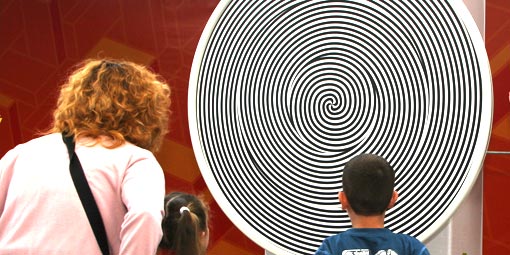


 |
||
 |
||
|
Visitors stare for several seconds at the center of a huge revolving spiral and then move their eyes to the wall or a stationary object, which they will see moving in distorted ways. At every point in our field of vision, there is a group of brain cells that responds to a movement in a particular direction. When cells in one of these groups work continuously for a while, they lose their sensitivity. The other cells continue to work spontaneously. The imbalance between them leads the brain to think there is movement in the opposite direction when, in reality, nothing is moving. When we spend enough time looking at movement in one direction, and then move our eyes to a stationary object, that object will appear to be moving in the opposite direction. This is an example of a phenomenon called "motion aftereffect", which results when we become adjusted to movement. The brain has defined areas whose job is to identify movement in our field of vision. These areas contain cells that are sensitive to specific directions of movement. When no movement is taking place, all the cells work to the same extent, and we therefore perceive no movement. When we stare for a while at a movement in a single direction, the brain adjusts to that movement, and the signal for it weakens. As a result, when we then look at an area where no movement is taking place, we perceive movement in the opposite direction. The reason for the reduced activity of cells associated with a particular direction movement is not that they become "tired," but that the brain adapts itself to a situation of continuous movement in order to better identify any change that takes place. The phenomenon is also referred to as the "waterfall effect," which was recorded by Robert Addams in 1834 after observing a waterfall at Foyers in Scotland. After moving his eyes from the waterfall to the surrounding rocks, it appeared to him that the rocks were moving upward. Links: Related exhibit:
|
||

 An Expanding Universe
An Expanding Universe